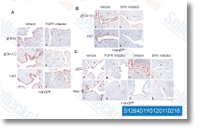even though they have been comparable on L selectin. Rolling velocities of CHO cells expressing pig or rat PSGL one were drastically higher than that of CHO cells expressing human PSGL one on both L and P selectin. whereas they rolled, like equine neutrophils, using the slowest velocities on L selectin. The stability of rolling velocities was assessed by measur ing CHO PSGL 1 cell and neutrophil displacements on human L selectin inside successive video frames. Peaks represent increases in velocity and valleys decreases. The stability of CHO PSGL one cell rolling veloci ties on human L selectin was heterogeneous amongst the studied species. Despite the fact that CHO cells expressing human and bovine PSGL one had related mrv, rolling velocities of CHO cells expressing bovine PSGL one were much less steady than individuals of cells expressing human PSGL one.
CHO cells expressing rat PSGL 1 were the least secure. The stability of neutrophil rolling velocities was also remarkably heterogeneous amongst the studied species. Human and equine neutrophils exhibited one of the most secure rolling velocities. whereas rat neutrophils were the least secure. Interestingly, selleck LDE225 pig neutrophils exhibited periods of really slow rolling alternating with sudden acceleration, quickly followed by deceleration. Bovine and equine neutrophils had comparable behaviors. Regardless of the presence of oligosaccharides recognized by HECA 452 and CSLEX 1 mAbs on each CHO cells and neutrophils expressing equine PSGL one, transfected CHO cells rolled considerably quicker and much less stably than equine neu 0. 001.
In comparison to CHO cells expressing human PSGL 1, elevated velocities of CHO cells expressing bovine PSGL one on P selectin ITF2357 might have resulted in greater cell recruitment on human selectins. The rolling velocities of human and bovine neutrophils on human P selectin didn’t differ considerably. whereas human neutrophils rolled slower on L selectin than bovine neutrophils. Remarkably, porcine neu trophils rolled using the fastest velocities on human P selectin identi fied by us or other folks. Many sequence alignments display that conservation of sequence just isn’t homo geneous along the protein, and that the primary sequence with the web page of interaction of L or P selectin is not properly conserved. All sequences contain a threonine homologous on the core 2 O glycosylated Thr 57 in human, as well as a T PP motif, that’s conserved in all species, except in horse and canine.
Nonetheless, even when the area preceding this threonine constantly contains no less than one particular tyrosine residue in an anionic environment and positions of your poten tially sulfated tyrosine residues are variable. Desulfation and sulfation  inhibition studies recommend that tyrosine sul fation plays a essential purpose in supporting mammalian PSGL one interaction with human L and P selectin. Data presented right here indicate that L and P selectin binding websites on PSGL one are evolutionary conserved and emphasize the role of threonine linked core two O glycans and tyrosine sulfate residues in supporting mammalian PSGL one inter actions with human selectins.
inhibition studies recommend that tyrosine sul fation plays a essential purpose in supporting mammalian PSGL one interaction with human L and P selectin. Data presented right here indicate that L and P selectin binding websites on PSGL one are evolutionary conserved and emphasize the role of threonine linked core two O glycans and tyrosine sulfate residues in supporting mammalian PSGL one inter actions with human selectins.
Mirna Array
Fast, easy and accurate miRNA profiling using mirna array
